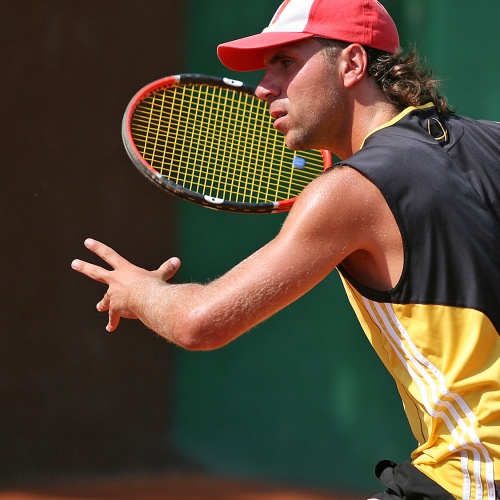After working for the last 7 years on the professional tennis tour as physio to Andy Murray, TenPhysio’s Andy Ireland is often asked about the ‘secrets’ that help the pros perform so well.
Here are a few of his pointers to help release the tennis superstar within you.
Fitness for tennis. Not tennis for fitness
You have to be fit to play tennis, and all too often I see amateur players seeking treatment for a variety of injuries, caused simply because their only exercise is tennis.
Playing tennis will make you fitter, but it can also give rise to a whole range of other issues like imbalances, overuse injuries, and strains. The more tennis you play without corrective exercise, the more this will happen and the more likely you will sustain an arm injury – shoulder issues are amongst the most common.
Preparation
For every hour spent on court, the pros spend many more on their aerobic fitness and in the gym, working on their strength, posture, and core. Often using a Pilates reformer as part of their regime because of its ability to restore functional movement, develop the core, and balance out the muscles.
Here are 5 exercises that the pros use to prepare their shoulders for tennis. They help improve muscle co-ordination, reduce joint stiffness, and enhance technique by making your movements flow better. Doing them regularly should help reduce the likelihood of shoulder and arm injuries. Doing them with both arms rather than just your tennis arm will also help reduce muscular imbalance. Make sure to maintain good posture throughout these exercises.
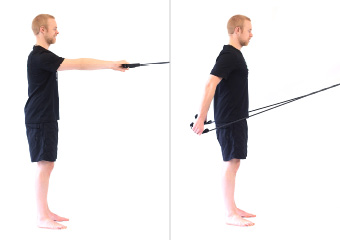
Stand with arm at shoulder height. Pull band straight down with elbows and wrists straight.
Don’t let your head or shoulders poke forwards.
Slowly release.
2. T-Row
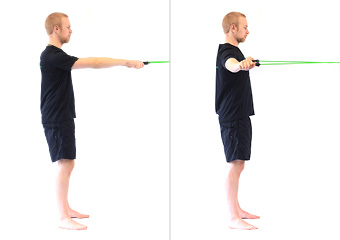
Stand with arms in front of body at shoulder height keeping shoulder girdles down and elbows straight.
Bring arms out to the side making a T-shape with your body. Don’t allow the shoulders to roll forwards or upwards.
Slowly release.
3. Shoulder External Rotation
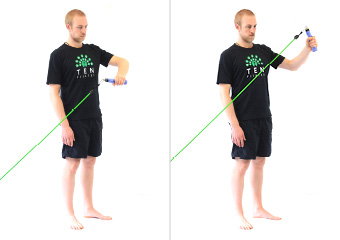
Stand with your arm at 90’, elbow slightly forward of the body.
Keeping your elbow stationary in the air and your wrist straight, rotate your arm upward. Keep your shoulder girdle down and back.
Slowly lower hand to start position.
4. Shoulder Internal Rotation
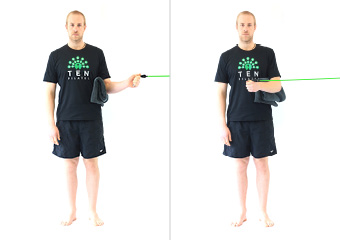
With your arm at 45 degrees, elbow bent and wrist straight, hold the resistance band as shown.
Keeping elbow stationary and your wrist straight, slowly rotate arm against resistance toward body. Don’t allow the shoulder girdle to roll forwards.
Slowly return to start position.
5. Overhead
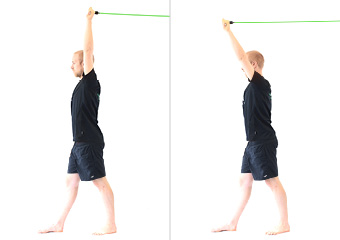
Stand holding the resistance band as shown. Keep elbow, wrist and back straight.
Stretch the band slightly by pushing the straight arm forwards about 30 degrees from the shoulder. Try to keep your shoulder girdle down away from your ears.
Slowly return to start position.
The warm up
If you want to play well and stay injury free you will also need to warm up before every game. Dynamic lunges, side steps, bottom kicks, trunk rotations, shoulder circles and arm swings all prepares the body for activity and should last 5 minutes for every hour played.
Check your equipment
In the non-elite player, inappropriate equipment racquet and string set up (wrong string type or tension, wrong sized grip etc), together with poor technique account for the majority of injuries. Have a tennis coach or sports physio review your equipment, to make sure it’s working with your body, not against it.
Cool Down and Recovery
The cool down is as important as the warm up so don’t skip it. It helps the body start the recovery process and should steadily lower the heart rate to resting levels. Once there, you can stretch, and even jump in an ice bath for 10 minutes like the pros do – but I’d only really recommend this for the ardent competitive player. The rest of us should be able to make do with an ice pack to nurse any injured limbs….10 minutes is the recommended time.
And for all those recurrent aches and pains that don’t settle after a few days, get along to see your physio. Or better still, me.





